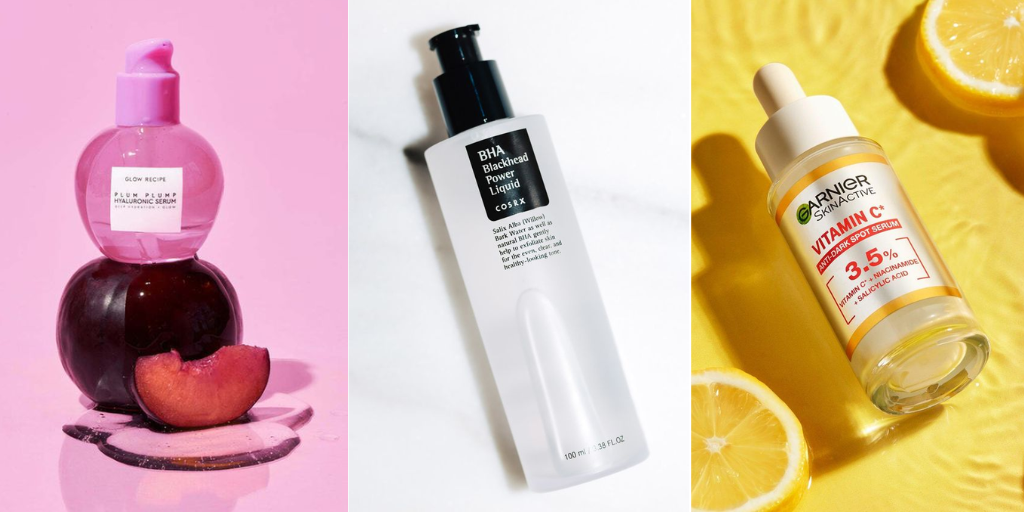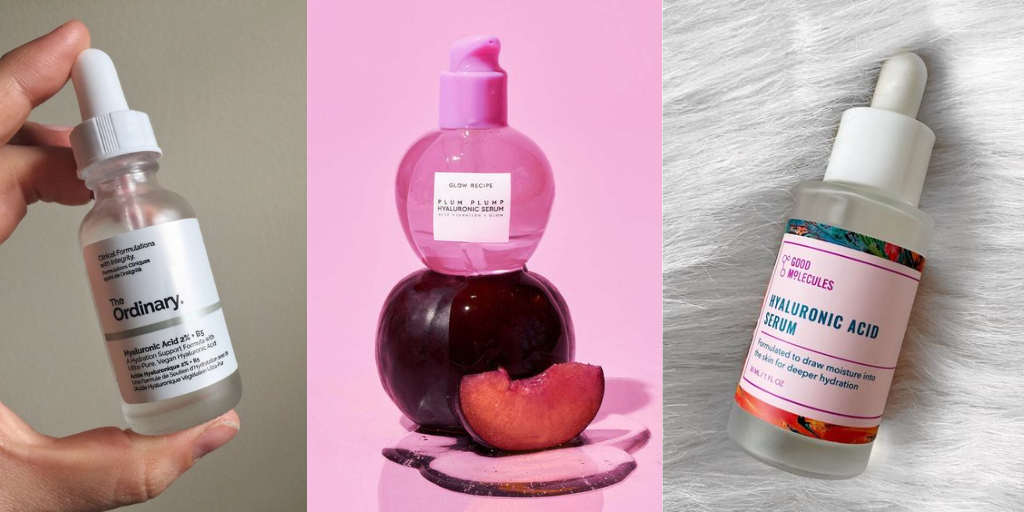
A Complete Guide to Skincare Actives
Skincare. It is an ever evolving science behind bright, glowing and healthy skin. The newest rage in the skincare industry is active ingredients like Vitamin C, Hyaluronic, Niacinamide etc. While many of these actives have been part of the ingredient list of skincare products, experts are only now understanding the huge role these actives play in making the products effective. Each active addresses a different skin concern and if incorporated properly, they can be a game changes for everyone. So here’s our complete guide to understanding skincare actives and how you can make the best use of them.
Here are the Most Common Skincare Actives
Hyaluronic Acid

Credits: buzzfeed.com, ebay.com, luxuryblush.co.uk
Hyaluronic Acid (HA) is a naturally occurring, gooey substance found in our joints, skin, and eyes. HA lubricates our tissues and plays an active role in skin health, wound healing, and bone health. As we age, Hyaluronic Acid starts to decrease in our body, leaving our skin dry and dehydrated. Applying HA tropically can help restore the skin’s moisture. The acid not only hydrates the skin but also has water retention capabilities and visibly reduces the appearance of fine lines and wrinkles.
Skin Type – Suitable for all skin types, but specially good for dry and dehydrated skin.
How and When to Use – Once you’re done cleansing, make sure you apply a few drops of HA on damp face. Any other actives that you use, go over Hyaluronic Acid since HA helps your skin absorb all the others products properly. HA, most effective in concentrations of 1 to 2%, can be used daily, in both AM and PM skincare routines.
How to Layer – HA mixes extremely well with other actives and is the safest product to apply topically. You can layer HA with Vitamin C, Glycolic Acid, Niacinamide and many other actives.
Niacinamide
One of the most common skincare actives, Niacinamide is a form of Vitamin B3, which is an essential vitamin for the proper development and function of cells in the body. When used topically, niacinamide has plenty of benefits such as anti inflammatory, skin repairing, cellular rejuvenation and reversing the effects of UV rays. It is specifically used to treat acne, acne scars and rosacea. It also improves skin tone and fades dark spots.
Skin Type – Niacinamide is one of the safest actives and is suitable for all skin types. But it is specially good for acne prone or tired skin.
How and When to Use – You can use niacinamide in both your AM and PM routines. Most niacinamide serums are water based so use them before your oil based products.
How to Layer – Niacinamide can be layered with many actives like hyaluronic acid, Vitamin C and retinol. After washing and toning your face, apply the other actives and top it off with niacinamide. You can even mix niacinamide serum with your moisturizer and apply that as the final step in your routine.
Vitamin C
One of the most widely trusted and used skincare actives is Vitamin C. It has quite an endless list of benefits for the skin. Not only does it have pro-ageing and skin brightening properties, but it also helps in providing hydration, reducing hyperpigmentation, reducing the appearance of dark circles, promoting collagen production, reducing the appearance of acne scars and the list goes on.
Skin Type – Even though vitamin C generally suits all skin types, different kinds of Vit C work for different types of skin. So do your own research before you choose a product.
How and When to Use – Vit C can be used twice daily, however many would vouch for its benefits when used only during the day time. We would suggest doing a patch test before you start using Vitamin C. Most importantly, always top it off with sunscreen since it temporarily increases your skin’s susceptibility to UV rays.
How to Layer – Vitamin C is a tricky active to layer. Make sure you never layer it with AHA, BHA, and Retinol or use it after chemical peeling. It does however, work wonders when layered with Niacinamide.
Alpha Hydroxy Acids (AHA)
Alpha Hydroxy Acids refer to a group of plant and animal based acids which are widely used in skincare products. There are many different kinds of AHAs in the market, but the most commonly used ones are Glycolic Acid, Citric Acid and Lactic Acid. These actives work as strong, deep exfoliators and are used mostly in cleaners, toners and serums. AHA specifically targets dryness and signs of ageing. It promotes collagen and blood flow, reduces dark spots, wrinkles and fine lines and brightens complexion.
Skin Type – Works best on dry, dehydrated and ageing skin.
How and When to Use – AHAs work best when used in the evening. It also increase the skin’s sensitivity to the sun so wearing SPF during the day is absolutely essential. Temporary side effects are possible when using these products so make sure you gradually introduce it in your skincare routine.
How to Layer – AHA is a strong active and doesn’t react well with many other products, especially Retinol. Do your research or consult a dermat before you mix products.
Beta Hydroxy Acids (BHA)
Just like AHA, BHA is also a group of chemical exfoliants. Most commonly used BHA is salicylic acid. While AHA targets dryness, BHA is best for acne prone and sensitive skin. It is slightly less irritated than AHA and targets a whole different category of skin problems like whiteheads, acne, redness, enlarged pores etc. Most common ways of including BHA in your skincare is through cleansers, toners and spot treatments.
Skin Type – Works best on oily, acne prone or sensitive skin as it has anti inflammatory properties.
How and When to Use – With acids like AHA and BHA, less is more. Start low and slowly allow your skin to get used to these products. BHA won’t make your skin as susceptible to UV rays as AHA does, still it is safer to use sunscreen when using these acids.
How to Layer – Do not layer AHA and BHA together. If you feel the need to use both products, use them on alternate days. Same is the case with Vitamin C. It is best to layer BHA with hydrating actives like Hyaluronic Acid, Niacinamide, Glycerin or Squalene.
Pro Tip: There are products that combine AHA and BHA, such as peeling solutions. These products are to be used occasionally and one should be extremely cautious while using them. Do your research, follow the instructions on the packaging to the T or visit a dermat if you need further guidance.
Retinol
A form of retinoid, retinol is a star ingredient for anti ageing. Derived from Vitamin A, retinol is widely used in anti ageing serums and creams. It treats acne, combats signs of ageing like photo damage, dark spots, wrinkles, fine lines and makes your skin plump and brightens skin tone. Retinol works on the deeper layers on your skin and promotes skin renewal by boosting collagen and elastin production.
Skin Type – Mature, ageing skin and acne prone skin are the most receptive to retinol.
How and When to Use – Retinol is used as the last step in your skincare routine. It can be used in the form of serums or creams. If you’re new to retinol, start with once a week and gradually increase it to twice or thrice a week. Don not forget to use SPF during the day time.
How to Layer – Do not, in any case, layer retinol with AHA, BHA and Vitamin C. However, you can layer it with Hyaluronic Acid and Niacinamide.
We hope you found this blog helpful. To know more about skincare actives and makeup, stay tuned to Styl Inc Blogs.
Keep’in it Styl’ ish,
Signing off,
Kashika
Disclaimer: We are not responsible if information made available on this site is not accurate, complete or current. The material on this site is provided for general information only and should not be relied upon or used as the sole basis for making decisions without consulting primary, more accurate, more complete or more timely sources of information. Any reliance on the material on this site is at your own risk. Any third-party trademarks, service marks, images and logos are the property of their respective owners. Any further rights not specifically granted herein are reserved.



No Comments